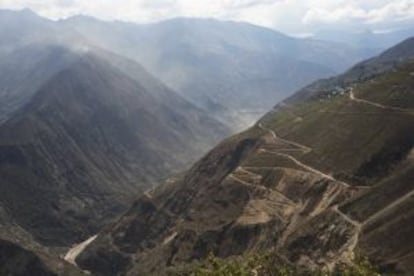96% of Peru land set for exploitation inhabited by local communities
Report warns of conflict risk between residents and mining, oil and logging firms

More than 40 percent of the surface of Peru has been earmarked for mining, logging, and oil and gas drilling, a new report shows. Yet 96 percent of this land is occupied by indigenous peoples and local communities.
A consultancy called The Munden Project analyzed 73,000 concessions in eight countries with tropical forests — Brazil, Cambodia, Colombia, Phillipines, Indonesia, Liberia, Mozambique and Peru — and found that over 93 percent of the total land handed over to private companies for exploitation is inhabited.
The consultants also looked at 100 local conflicts arising from these practices, in which governments often grant operators rights to a concession without even informing the people who live on the land.
“The granting of concessions without the knowledge or approval of people directly affected by them is obviously a human-rights issue of grave concern. But it may also have a real financial impact,” warn the authors of Communities as Counterparties, a study commissioned by The Rights & Resources Initiative, a global partnership engaged in land policy reform.
“Even if concessions provide the right [to operate] from a legal point of view, these are frequently challenged where there is tension between a company and the local population.”
Researchers refer to these local populations as “unrecognized counterparties” to concession agreements, and warn investors about the high financial costs of negative interaction between the concessionaire and the communities.
The Peruvian state has organized the territory to maximize investment” Prof. Anthony Bebbington
Of the 100 conflicts analyzed by the study, 10 projects were completely halted, most of them in Peru.
“There’s something making communities mobilize more here and making confrontations more violent, even to the point of deaths, unlike other countries where conflicts play out in the legal system or through other channels,” said the Brazilian researcher Leonardo Pradela, one of the authors of the report.
Compared with the other seven countries in the study, Peru had the largest number of mining concessions (59,159), followed by Colombia (9,464). Brazil had reserved the largest land area for gas and oil exploration (239,832 km2), followed by Peru (203,258 km2) and Colombia (155,903 km2).

“The state must switch from a sectorial to a territorial vision that includes the people, the environment and the resources all at once, the way indigenous people do,” says Gustavo Suárez de Freitas, coordinator of the Program for Forest Conservation to Mitigate Climate Change, which answers to the Peruvian Environment Ministry.
“In order to avoid conflict between the different uses of the territory, the right-granting mechanisms have to be clear,” adds Suárez de Freitas, who admits that Peru still lacks a law to “grant rights in an orderly manner.”
Alberto Pizango, leader of Aidesep, the largest indigenous organization in the Peruvian section of the Amazon rain forest, says that more than 1,000 native communities are waiting for the state to certify their ownership of 20 million hectares of land. Their lack of title deeds has made them vulnerable before illegal loggers and informal mining, and it puts them in a weaker position in negotiations with mining and oil companies.
Anthony Bebbington, a geographer at Clark University in the United States, recently mapped out a rise in mining and oil concessions on agricultural land and river basins in Ghana and Peru.
“These maps show how the Peruvian state has organized the territory to maximize investment,” notes Bebbington. “Another system could allow productive diversification and reinforce the country’s resilience against climate change.”
Tu suscripción se está usando en otro dispositivo
¿Quieres añadir otro usuario a tu suscripción?
Si continúas leyendo en este dispositivo, no se podrá leer en el otro.
FlechaTu suscripción se está usando en otro dispositivo y solo puedes acceder a EL PAÍS desde un dispositivo a la vez.
Si quieres compartir tu cuenta, cambia tu suscripción a la modalidad Premium, así podrás añadir otro usuario. Cada uno accederá con su propia cuenta de email, lo que os permitirá personalizar vuestra experiencia en EL PAÍS.
¿Tienes una suscripción de empresa? Accede aquí para contratar más cuentas.
En el caso de no saber quién está usando tu cuenta, te recomendamos cambiar tu contraseña aquí.
Si decides continuar compartiendo tu cuenta, este mensaje se mostrará en tu dispositivo y en el de la otra persona que está usando tu cuenta de forma indefinida, afectando a tu experiencia de lectura. Puedes consultar aquí los términos y condiciones de la suscripción digital.








































